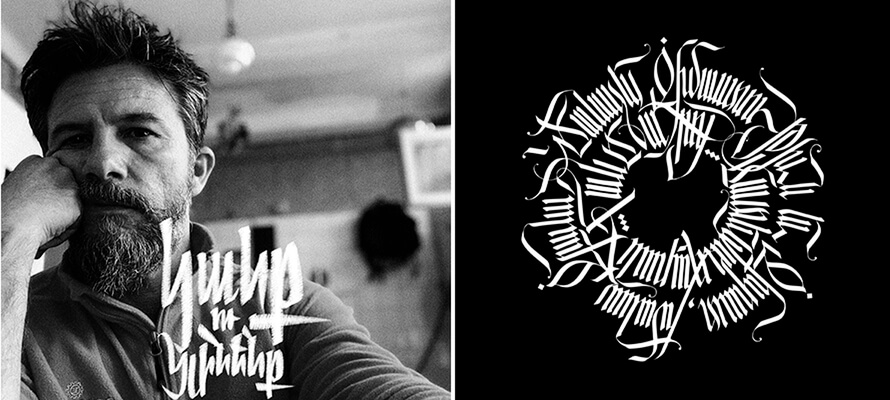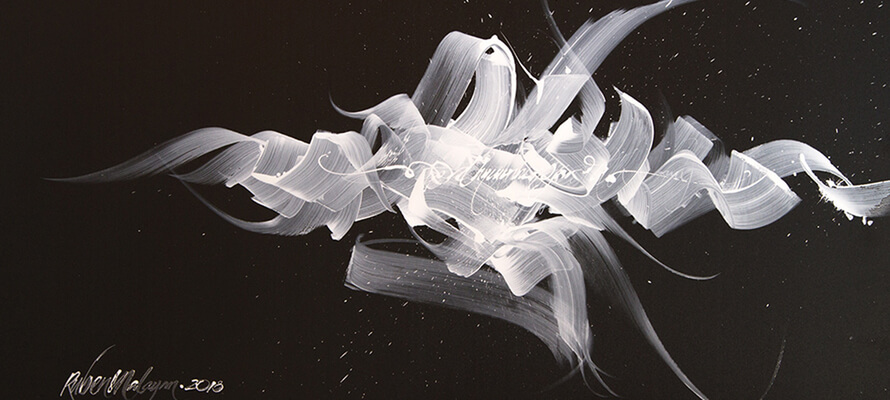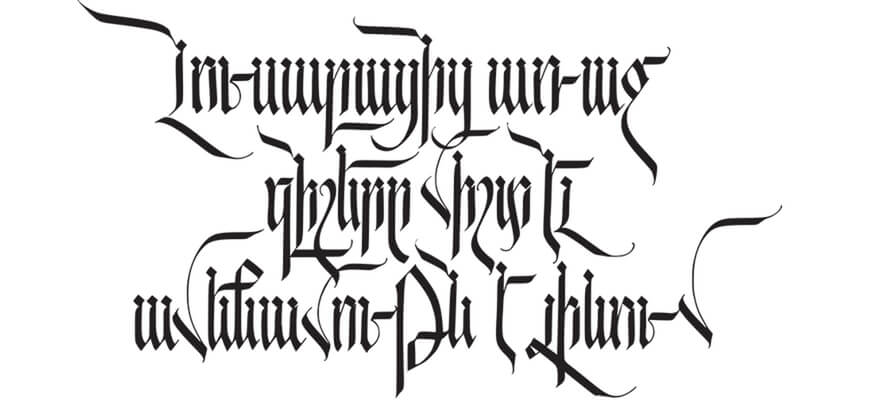Ruben Malayan, the written word is freedom
Art director, visual artist, calligrapher, university lecturer, polyglot, cosmopolitan, Ruben Malayan has turned his mother tongue - Armenian - into a visual language of immense expressive power. Far, however, from a merely aestheticising function: design, in fact, has a very important social role, that is telling the truth.
In this interview, we immerse ourselves in the very history of the written word and the fundamental role it still plays today for all mankind: a bridge between different cultures and a vehicle for freedom.
By Stefano Torregrossa | On PRINTlovers 99
As a calligrapher, you deal with writing, which is probably among the most influent inventions of humanity ever. Plus, Armenia is involved in the history of writing in its very beginning. Can you tell more? And how do you deal with such heritage?
Archaeological digs of the last decades on the territory of the Armenian Plateau show signs of a developed a culture capable of building temples and using agriculture around 12-7th millennium B.C., – making it one of the oldest inhabited parts of the world. There is a passage generally regarded as the Sumerian account of the invention of writing and the writing medium clay tablet, and which credits Enmerkar as their inventor. Writing arose from a verbal argument of King of Ur and the King of Arrata.The description of the geographical location of Aratta is given in the poem through various metaphors, however it is being specific about the highly mountainous terrain, mentions the necessary passage through Uruki river (there are two major rivers connecting Mesopotamia to Armenian Highland - Euphrates & Tigris) and various toponyms such as lake Zamua (Urmia, current location in Iran) on the journey from Sumer. Aratta is nothing but Ararat, and its indigenous people - Armenians, who after a millennia regained independence, established Ararat (Urartu) Kingdom with its capital at Van and who were, at least partially, speakers of Armenian.
So our language is just as old, perhaps as old as the very beginning of the Indo-European language family. It is impossible to contemplate, without amazement, the literary quality of the remnants of that language. The richness, purity, choice, poetic adornment, taste and philosophy found in the style of their exquisite relics, all indicate a high degree of national political and intellectual culture. Recent linguistic DNA research confirmed Grabar Գրաբար (Old Armenian) as the likely candidate for proto-Indo-European language, along with two variations of Old Greek. The research does point to the Armenian plateau as the geographical location for the formation of the Indo-European language family.
You once said “The message always comes before the writing”. Written words always convey a message: do you think that calligraphers (and so designers and artists) have a role in educating people? If so, how?
Design has a social function. I cannot be satisfied with a design which is used only for selling things. The world is on fire and designers have an obligation, a moral obligation to spread the message, the message they believe in. Truth must be told, by us, visually. I do that through hand-writing. Calligraphy here functions the same, for the same purpose - to set the narrative.
You are from Armenia, but you lived and worked all around the world. How does your culture and origins affect the way you work with yours and other written languages?
I believe the more culturally diverse your experience is, richer the work you produce will be. Every language is a world of ideas reflecting the geography and social structure. I speak four languages and I have lived in four cultures. It has its influence on my work, when it comes to Armenian script. I learn from others and also try to enrich my own culture by incorporating that experience in my own practice.
Where do you find inspiration for your works?
The inspiration is in an endless layer of my own culture. From epigraphy to the art of the book. Centuries of written tradition.
How important is perfection in your work?
For me a written letter represents much more than just means to communicate. Digital overcomes analogue as another step in technological progress, but digital does not have a smell or is susceptible to touch. I love the material and I love the struggle with material. The aiming for the perfection of form and expressivity of letter characters is what drives me forward. I want to create a counter-balance to digital, to keep the tradition of working with perishable material, but not only. I love stone too. I carve letters in stone too. Calligraphy is a part of letter culture and will always remain so for me.
How does handwritten calligraphy and digital design interact in your works?
Paradoxically what I write on paper ends up on a digital screen. Its seen mostly in its digital reincarnation. That devalues it to a certain extent. A replication cannot be compared to the original, just like a reproduction of Rembrandt's painting cannot be compared to the original work. But this is the reality we live in. The only way to deal with it, is to maintain the same level of performance, both on paper and later in digital.
Apparently, written words today are mostly digitally written. And these words are immediately spread all around the world. Do you think this is an improvement for human language? Or did we miss something, losing the art of handwriting?
I don't really agree that we are losing the art of handwriting. I think it's on the rise actually. The efforts of very talented calligraphers pay off. Take Luca Barcellona, the way that he is able to combine both. He is an excellent example, from your own culture. Digital is the future, no doubt there. But we create the counter-balance by continuing to work with analog materials.
Trends and styles are always changing. What is considered “nice” or “well-designed” today, may be considered ugly tomorrow. Where do you see calligraphy in ten years from now on?
Calligraphy will adapt, because its made by humans and humans adapt to new realities. At the end of the day it's another means to deliver a message. Aestetic message. A statement about our cultural heritage that counts thousands of years. I don't fear for its future.
—
"I am not an abstract artist, but toward the end of 2018 revolution I began making semi-abstract large compositions, which were done almost intuitively. Its hard to relinquish control, especially if you are trained as a figurative artist, but at the other end of the rope there is a lot to discover. I realized if I try to use less cognitive process of writing but rather let the subconscious guide my hand, then something takes over and the energy is transmitted to the surface is more uninterrupted flow. There is a word written nevertheless on this work and its ազատություն - freedom."
"This is myself with a text written digitally in Procreate which reads Կանք ու կլինենք "We are and will be" meaning we will not disappear. It was done during one of those low dives we have experienced during the past 5 years - lost a war and 5000 young men were dead at the end of it, what followed was bitter disappointment and withdrawal. There were moments when the emotional field was one of the most intense feelings I ever had, I feared for my people and my culture. I still wonder why they hate us so much. I suppose our existence does not let them sleep at night."
"Like I said, this intensity coupled with limiting control of one's hand resulted in this image, which I named Counter-Revolution. It represents to me the hostile forces, but not the external but the internal enemy - the "Fifth Column". I realized that these were the mad "dogs of war", as I remembered Pink Floyd's track with the same name. The amazing part is that I was not conscious of what my hand was doing with the pump marker, but I remember the forceful way of making the strokes thinking that PVC will be able to take it. Paper would disintegrate momentarily in this situation. I consider this poster one of the pinnacles of my work so far."
"When the crisis deepened, our government refused to take the responsibility, nobody was made responsible for the death of thousands of our soldiers, nobody was tried and nobody resigned their position. Burning a chair, as a symbol of power, was rational to me, but then I also recalled Gunter Rambow's Antigone poster from 1978, I remember seeing it as a child - my father went to Poland a few times and returned home with large prints of posters. A childhood memory resurfaced in this work. The process of making it is documented and you can watch it on youtube."






